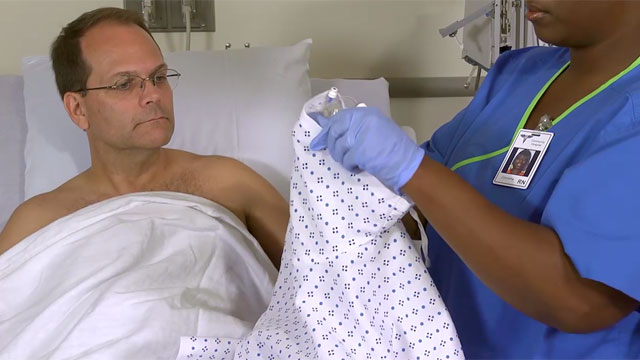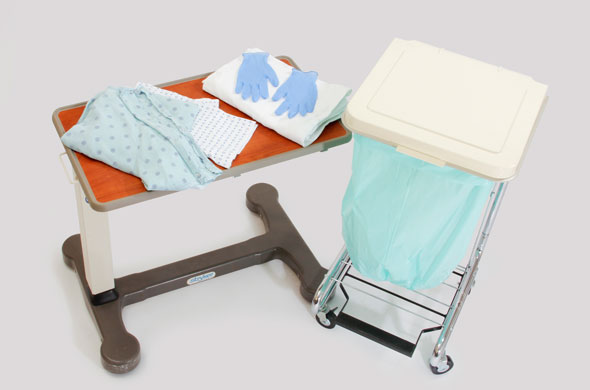Personal Hygiene and Grooming
Select a Skill:
- » Performing Oral Hygiene for an Unconscious Patient
- » Cleaning Dentures
- » Performing Hair Care and Shampooing in Bed
- » Shaving a Male Patient
- » Performing Nail and Foot Care
- » Assisting with a Gown Change
Take the Review Test:

Safety
- Observe Standard Precautions, including wearing clean gloves, when providing care. Additional precautions requiring other personal protective equipment (PPE) may be necessary, depending on the patient’s condition.
- Be aware of the presence and position of external medical devices or equipment, such as intravenous lines, nasogastric tubes, or oxygen tubing.
- Be aware of the range of motion of the patient’s upper extremities during the gown change. Avoid moving the patient beyond these limitations.
- Review any orders for specific precautions concerning the patient’s movement or positioning.
- Use proper body mechanics when positioning or moving the patient.
Equipment
(Roll cursor over items to see labels)

Bath blanket
Clean hospital gown or patient's pajamas
Linen bag
Clean gloves (optional)
Delegation
The skill of assisting with a gown change can be delegated to nursing assistive personnel (NAP) if the patient’s gown has snap sleeves. Do not delegate the skill of assisting with a gown change if the patient has intravenous lines and the gown does not have snap sleeves. Be sure to inform NAP of the following:
- Explain the proper way to position the patient with musculoskeletal limitations or an indwelling urinary catheter or other equipment, such as a nasogastric tube or intravenous line.
- What to report to the nurse, such as any limitations with positioning of the patient or complications caused by equipment like an indwelling catheter, nasogastric tube or intravenous line.
Preparation
- Review orders for specific precautions concerning the patient’s movement or positioning.
- Assess the environment for safety, such as checking the room for spills, making sure equipment is working properly, and ensuring that the bed is in the locked, low position.
- Identify any restrictions on the patient’s mobility.
- Assess the patient’s hand grasp and the range of motion of the extremities.
- Assess for the presence and position of external medical devices or equipment, such as intravenous lines, nasogastric tubes, or oxygen tubing.
- Determine what specific clothing is required for the patient.
- Ask if the patient has any clothing preferences or requests.
- Apply clean gloves if the patient’s gown is wet or soiled with blood or body fluids.
- Identify risks for skin impairment, including the following:
- Weakened or disabled patients and those with immobilization because of paralysis, immobilized extremities, or traction
- External devices applied to or around skin, such as casts, braces, restraints, dressings, catheters, or tubes
- Incontinence of bowel or bladder
Follow-up
- Observe the patient’s range of motion during the gown change.
- Ask the patient to rate his or her level of comfort, using a scale of 0 to 10.
- Ask if the patient feels fatigued.
Documentation
- The skill of changing a patient’s gown is not documented.
Review Questions
1. When preparing to assist a patient with a gown change, the nurse will promote infection control by doing what after performing hand hygiene?
 Placing the gown in the linen hamper
Placing the gown in the linen hamper Applying clean gloves
Applying clean gloves Determining whether the gown being changed is wet or soiled
Determining whether the gown being changed is wet or soiled Measuring the patient's temperature to determine whether it is elevated
Measuring the patient's temperature to determine whether it is elevated
2. When changing the soiled gown of a patient with left-sided paralysis, what will the nurse do first?
 Remove the sleeve from the weaker arm
Remove the sleeve from the weaker arm  Roll the patient into a prone position
Roll the patient into a prone position  Help the patient assume a side-lying position
Help the patient assume a side-lying position  Remove the sleeve from the stronger arm
Remove the sleeve from the stronger arm
3. When changing a patient’s gown, the nurse will place the bed in which position?
 A comfortable working height for the nurse
A comfortable working height for the nurse A height that allows the patient full range of motion
A height that allows the patient full range of motion Locked and low
Locked and low All side rails raised
All side rails raised
4. What will the nurse do when a gown change is needed for a patient who is receiving intravenous fluids delivered by a pump?
 Document that the tubing had to be disconnected in order to change the gown
Document that the tubing had to be disconnected in order to change the gown Ask another nurse to monitor the pump during the gown change
Ask another nurse to monitor the pump during the gown change  Pause the infusion by pressing the sensor on the pump
Pause the infusion by pressing the sensor on the pump  Help the patient maintain good hygiene until the infusion is discontinued and the gown can be changed
Help the patient maintain good hygiene until the infusion is discontinued and the gown can be changed
5. Why must the nurse check the flow rate after changing the gown of a patient who is receiving intravenous fluids infused by gravity?
 To make sure the patient's position change has not sealed off the drip chamber
To make sure the patient's position change has not sealed off the drip chamber  To check whether manipulation of the intravenous container and tubing has disrupted the flow rate
To check whether manipulation of the intravenous container and tubing has disrupted the flow rate To see if an increase in the patient's heart rate has accelerated the flow rate
To see if an increase in the patient's heart rate has accelerated the flow rate To make the standard periodic flow rate adjustment
To make the standard periodic flow rate adjustment
You have completed the Review Questions for this skill. To take the Review again select the Start Over button. To proceed to another skill select from the dropdown menu. Select the Home or Back button to proceed to the next section.

